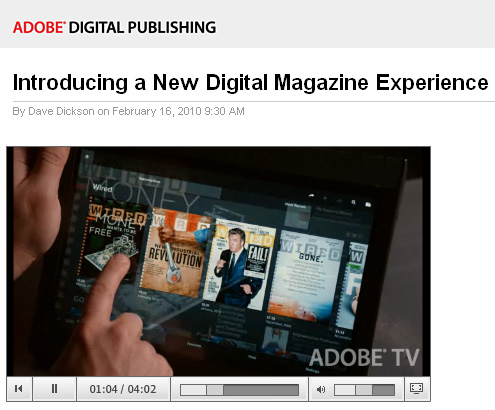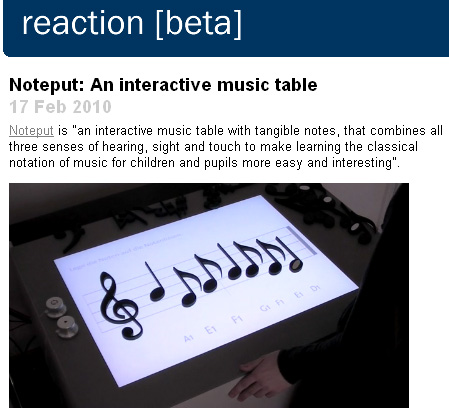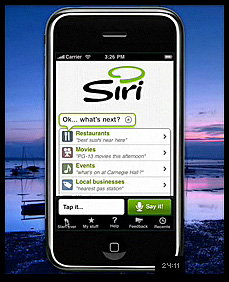Noteput: An interactive music table — from etre.com
Also see http://www.jonasheuer.de/index.php/noteput/ — An interactive music table with tangible notes, that helps students to learn the notation of music.
Why if you miss Siri you’ll miss the future of the Web — from Scobleizer
Siri is the most useful thing I’ve seen so far this year. But after playing with it, getting an interview with its CEO (video here on building43) it’s even more important for you to pay attention to. It is the best example of what the web will be (emphasis DSC).
From DSC:
In the interview this quote stood out for me: “Siri is a ‘do’-engine…not a search engine.”
Also see:
Meet Siri, the iPhone App from the Future (available now!) — from Profhacker.com
Delegated computing and the future of the web — from Siri.com
-
Dynamic Service Delegation
-
Meta-data Driven
-
Algorithmic Combination
-
The Future of the Web
Siri is just a beginning step to realizing this vision of “delegated computing”, where all the world’s services are being dynamically combined at the user’s beck and call. I do strongly agree with Robert’s post in that I believe that this will happen and that delegated computing will be an import part of the future of the web, and the way we interact with computers in general.
Interaction 10: A Take-Home Quiz — from changeorder blog
Identify the following statements as True or False. Show your work.
Better User Experience With Storytelling, Part 2 — from SmashingMagazine.com by Francisco Inchauste
RENCI pioneering the visualization industry with innovative interfaces — from InnovativeInteractivity.com by Tracy Boyer
“Today I flew through a digitally enhanced simulation of an ear canal, looked at 3D manipulations of static 2D images, and watched a seamless video projected simultaneously on four surrounding walls. The Renaissance Computing Institute (RENCI) is based in North Carolina and oddly enough it was my first visit to this extremely innovative and eye-opening interactive institute. Not only did it get me excited about information visualization, it gave me tons of inspiration for the future of immersive and interactive multimedia. Here is a great overview video of a similar tour group that went through RENCI. I experienced the first two visualizations that are shown here…”
3 Ways journalism classes are making education more interactive — from 10000words.net
Designing for the next generation of devices – don’t get left behind — from boagworld
Quote from Leigh Howells:
I believe we live in a world where the hand-held web device equipped with an accelerometer is going to become more and more prevalent, and quickly.
Radio Johnny: Jon Kolko’s Thoughts on Interaction Design — from JohnnyHolland.org
Summary: Jeff Parks talks with Co-Editor-In-Chief of Interactions Magazine, and Associate Creative Director at frog design, Jon Kolko about his publication “Thoughts on Interaction Design”. Jon shares a variety of ideas including the need to differentiate design research from market research; the importance of creating a balanced corporate culture; and how we as UX practitioners need to not lose sight of the elements of craft, execution, and appropriateness when working towards our ultimate goal of creating great experiences for our clients.
Finds: What Makes Design Seem Intuitive? — from Williams Instructional Design, LLC
This entertaining and informative presentation by Jared spool of User Interface Engineering on, “What Makes Design Seem Intuitive?,” addresses web design, but much of his message applies to instructional design as well. Some of the gems of insight include…(see posting)
From DSC:
When we put educational materials online, we instantly create a user interface. From the students’ standpoints, how intuitive/usable are those interfaces?
When we don’t enforce some type of consistency in our online-based offerings, do we not put the monkeys on the back of our students to try and figure out how their current instructor does things (i.e. where the syllabus is, where the discussion board forums are, etc.)?
And might I add in here (which I realize is controversial), this is yet another reason why we need to move towards the use of teams in higher ed. One person can not do it all anymore…it’s just too big of a job now. We can’t expect our subject matter experts to be usability/interface design/instructional design/interaction design specialists.
From DSC:
The posting below is a great resource for all educators — especially those involved with putting materials online — as well as for folks interested in interaction design/usability. Check it out!
There is power in digital storytelling (and eliciting emotion), so this posting really caught my eye! You might want to check out Francisco Inchauste’s blog as well. Nice work!
Better User Experience With Storytelling – Part One — from SmashingMagazine.com by Francisco Inchauste
Stories have defined our world. They have been with us since the dawn of communication, from cave walls to the tall tales recounted around fires. They have continued to evolve with their purpose remaining the same: To entertain, to share common experiences, to teach, and to pass on traditions.
Today we communicate a bit differently. Our information is fragmented across various mass-media channels and delivered through ever-changing technology. It has become watered down, cloned, and is churned out quickly in 140-character blurbs. We’ve lost that personal touch where we find an emotional connection that makes us care.
Resources
- Star Wars Origins
- Emotional Design by Donald Norman
- A Practical Guide to The Hero with a Thousand Faces by Joseph Campbell
- “Experience Themes” by Cindy Chastain
- “Storytelling – A Compelling Design Tool” by Dorelle Rabinowitz
- “The Art of Storytelling” by Christian Saylor
- “A Case for Web Storytelling” by Curt Cloninger
- Personas and How to Increase the Quality of Solutions













